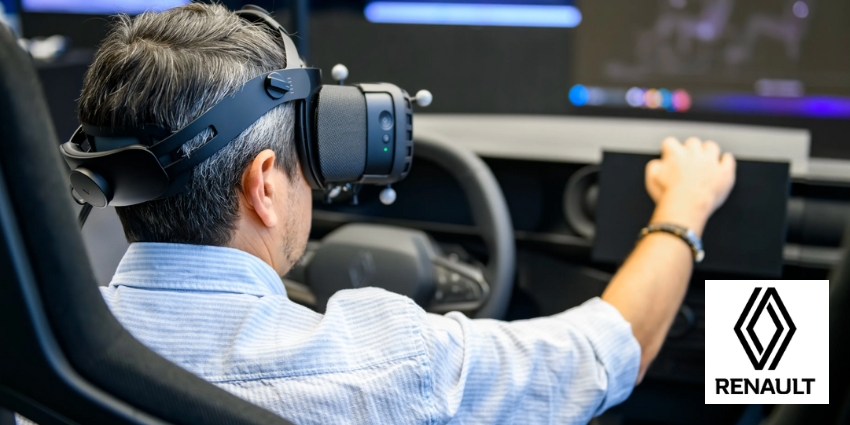Thinking about diving into extended reality for training, product development, collaboration, or just a fantastic customer service experience? First, you need to get real about the actual XR security risks enterprises face now.
Extended Reality is similar to AI (the other hot topic in tech right now), in the sense that really incredible immersive experiences revolve around data. That data is valuable, not just to your company, but to criminals and bad actors too.
XR headsets and devices devour data, mapping factory floors, scanning employee faces, capturing voices, eye movements, conversations, and even body language. These tools see companies, store knowledge, and if they’re not secured correctly, they create vulnerabilities.
Fortunately, we’re big believers in the idea that knowledge is power. When you understand the scope of the risk that comes with bringing immersive tech into your workplace, you’re more equipped to fight off the threats.
XR Security Risks: Why XR is Vulnerable
XR security risks are more extensive than most companies realize. Securing VR and MR headsets or AR smart glasses isn’t just a matter of using device management tools to track where your tech is, and who’s accessing it. A big part of XR security is data security.
Just look at all of the information cutting-edge headsets capture today.
- Environmental Data: Whether you’re actively scanning environments to create digital twins, or your devices are just using mapping capabilities to enable spatial experiences, XR devices can learn a lot about your spaces. If that data’s intercepted, it could reveal sensitive information about physical spaces, from warehouses to offices.
- Biometric and Behavioral Data: To tailor experiences, XR systems gather biometric data like eye movements, facial expressions, and even heart rates. This data is incredibly personal and, if compromised, could lead to identity theft. Unlike passwords, you can’t change your biometrics.
- Device Data: XR setups often involve multiple devices, headsets, controllers, sensors, all communicating in real-time. Each connection point is a potential vulnerability. If one device is compromised, it can serve as a gateway to the entire system.
- Ambient Data: Microphones and cameras in XR devices can inadvertently record conversations or capture sensitive visuals without users realizing it. Your tools could easily capture important information that then becomes vulnerable to hackers.
Even the smallest amount of sensitive data poses a risk. One Berkley study found that two seconds of hand or eye movement data could help a criminal identify a unique user.
The XR Security Risks You Need to Know
XR doesn’t just connect to reality, it blends into it. And as exciting as that sounds, it also means every breach, every vulnerability, every weird data quirk hits closer to home. As more companies continue to embrace XR (the market is expected to be worth $1625.48 billion by 2032), the XR security risks are mounting, particularly in regulated industries.
The biggest threats to watch out for?
Spatial Data Breaches
Spatial data leakage sounds like an abstract concept, but it’s not. Headsets and XR apps are gathering huge amounts of spatial data. A system could map an entire R&D lab in millimeter-perfect 3D to overlay a virtual instruction set. That’s helpful for training, but now that map exists somewhere.
It might be stored on a cloud server you didn’t configure or cached on a headset someone forgot to wipe before reselling it on eBay. Every digital twin or temporary map created for a spatial computing experience creates an echo that criminals can tap into.
You’re not just leaking building blueprints, you’re exposing operational flows, who sits where, what prototypes are on that table. This level of detail has been dubbed “behavioral cartography”, and it creates a unique level of risk for today’s teams.
Avatar Spoofing and Deepfakes
Look at all the XR collaboration tools companies use today. Most allow teams to develop custom avatars that can increasingly precisely mimic their appearance and voices. If a criminal gets hold of the biometric data a team member uses to create an avatar, nothing is stopping them from using AI to build a convincing deepfake.
Countless celebrities have already been replicated in the metaverse with AI. If someone mimics your CEO, or CFO, they could step into a board meeting, gather sensitive data, and even influence business behavior without anyone noticing.
The XR security risks aren’t just from sneaky corporate espionage either. There’s the threat of employees losing their identities to potential bad actors, which takes us to our next issue.
Biometric Data Theft
Biometric data is intimate. It’s not just your password, it’s your body, your emotions, your reflexes, your stress levels. The latest XR headsets soak all of this information up. That’s a good thing to a certain point. Biometric insights can lead to smoother, more personalized immersive experiences, and give business leaders more valuable data to work with.
But biometric data is also valuable to attackers. Not all biometric data is secured “as standard” on headsets and XR apps. Plus, third-party plugins for analytics and personalization, or external apps, can introduce new data access points and XR security risks.
If the information is harvested by the wrong people, it could lead to behavioral profiling, identity theft, and noncompliance with standards like GDPR.
Platform and Endpoint Vulnerabilities
We tend to forget: XR headsets are endpoints, not just accessories. Full-blown, internet-connected, sensor-packed computing devices with operating systems and firmware, most of which don’t update themselves. And they’re usually not part of your standard IT endpoint management suite.
Although some solutions support device and app management software, like Meta Quest for Business, others don’t. That means it’s difficult to really keep track of how secure your systems are, patch vulnerabilities, and lock APIs at scale.
What makes this scarier is how fragmented XR ecosystems are. You’ve got hardware from Meta, software from Unity, cloud integration with Azure, and maybe an AR plug-in for Salesforce. There’s a lot to keep track of.
Ambient Eavesdropping
This is one of the top XR security risks that really makes employees nervous. XR headsets today have microphones, cameras, sensors, And trackers built in. Sometimes, when people are deep in a collaborative design session, they’re not thinking about what these devices are hearing or seeing.
These devices can pick up conversations, images, and sounds that weren’t meant to be captured. If you’re streaming XR experiences in the cloud, there’s even a chance that criminals could listen in on conversations without anyone realizing.
If crucial financial data, product data, or other sensitive information is stored and logged, this could lead to serious ransomware attacks and breaches.
XR Security Risks: Analyst Warnings and Regulations
XR security risks are on everyone’s radar. Worldwide, groups are waking up to the challenges posed by these technologies. Regulators are paying attention. Privacy advocates are sounding alarms. Even end users are starting to ask, “Wait, what exactly is this headset recording?”
The rules are changing fast too. It’s not enough to be just GDPR compliant. Companies diving into XR now have to navigate a growing stack of regulations that get very specific, very quickly, especially when it comes to biometric data, spatial mapping, and behavioral insights.
Global standards bodies are catching up, too. ISO/IEC has already started laying down foundations for how immersive systems should handle sensitive data. Organizations like the XR Association and IEEE are stepping up with new playbooks focused on ethics, privacy, and platform integrity.
Industry voices aren’t staying quiet either. The XR Safety Initiative (XRSI) recently called out the urgent need for standardized privacy frameworks built specifically for immersive tech. Without them, businesses risk more than fines—they risk losing user trust at a time when trust is currency. The Future of Privacy Forum (FPF) echoed that call with a detailed framework to manage body-related data in XR environments.
Bottom line? XR security isn’t just about locking down data. It’s about building systems that are safe, transparent, and future-proof. If you’re not thinking about compliance, ethics, and reputation all at once, you’re probably already behind.
Addressing XR Security Risks
So, let’s say something goes wrong, a breach, a leak, a security “incident.” What happens next? Potentially a lot. XR is everywhere right now.
It’s how frontline workers follow repair procedures, and how engineers present prototypes to clients. Leadership runs remote town halls, training, and collaborative experiences with XR.
So if that system goes down, it’s disruptive. Training halts. Projects stall. Teams go dark. If a breach exposes sensitive data, that can lead to serious losses, not to mention reputation damage. Companies need to take a proactive approach. That means:
- Nailing the Fundamentals: Choosing platforms and systems that support end-to-end encryption, strong authentication options, and endpoint device management.
- Getting Creative: Experimenting with secure sandboxes for VR simulations, using zero-trust networking practices, and accessing AI to monitor for threats in real-time.
- Staying Educated: Training your teams on potential XR security risks, safety best practices, and disaster response processes.
It may also mean investing in more specific solutions for XR security, like PICO’s device management tools, ArborXR, or Meta Quest for Business.
XR Security Risks are Growing: Be Prepared
XR is a valuable resource for enterprises, enhancing training, collaboration, product development and more – but it’s not risk free. The deeper we dive into the immersive world, the more we expose devices, data, and users to new threats.
The threats will keep coming, but with a little preparation, they don’t have to catch you off-guard.







